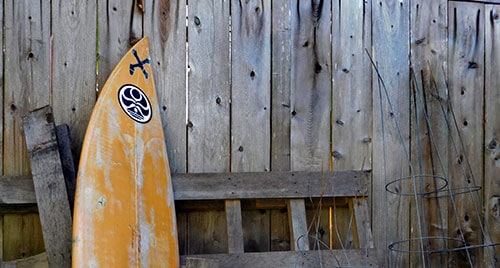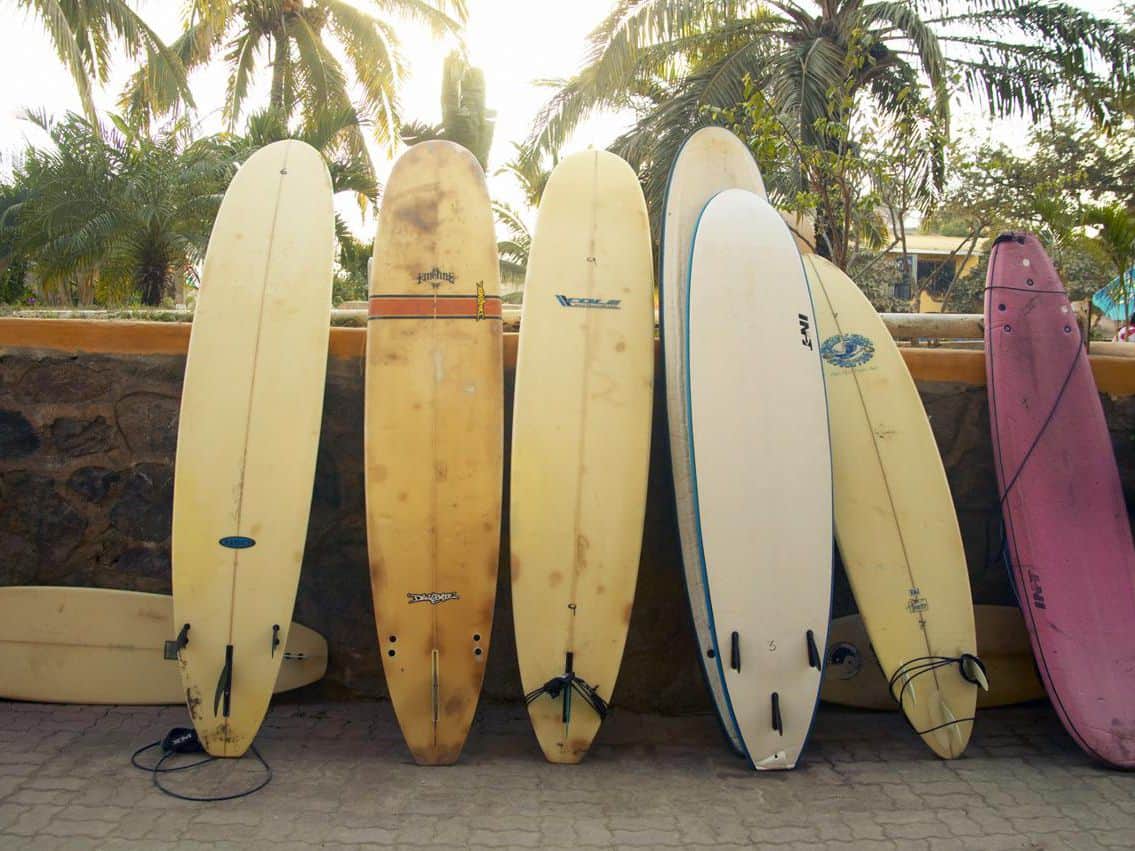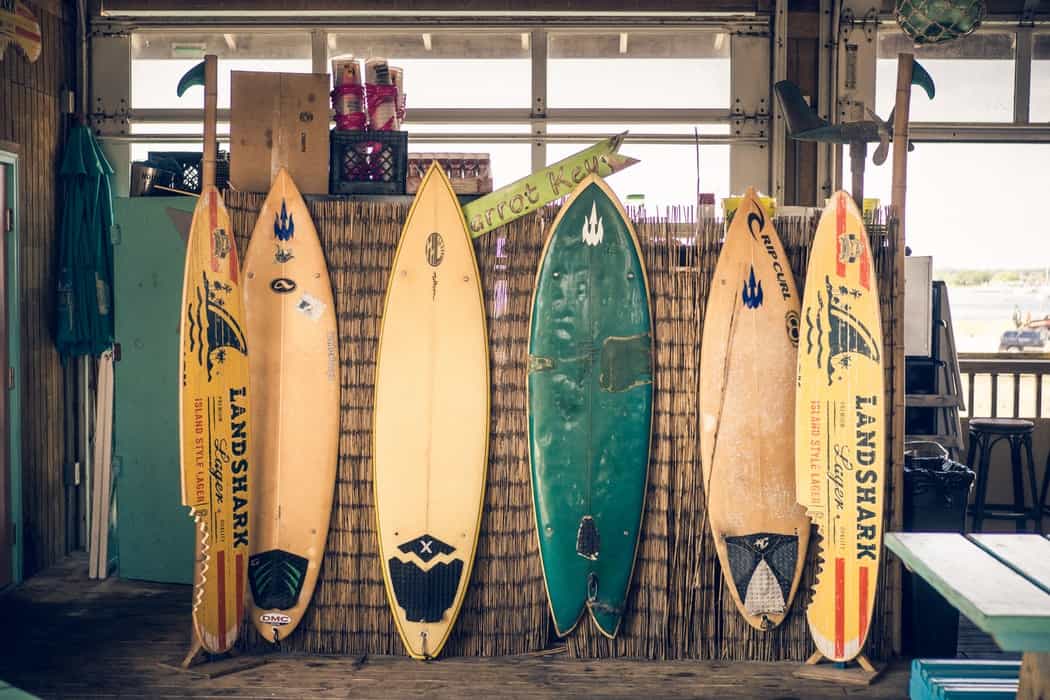Surfboards go through a lot of abuse. Not only do we get dings on them, but we leave them exposed to the sun far too long. Sand and grime build up on the surface when we neglect our boards causing the deck, rails and underbody of the board to wear down. Deck yellowing happens too, giving a sickly pallor.
Why do surfboards turn yellow? The Sun’s ultraviolet (UV) rays cause the resin on the deck surface to turn from white to yellow. However, the board itself can still be used. There is no change in a surfboard’s functionality aside from the change in color to yellow. You may be wondering if there are ways you can prevent your board from turning yellow and if there are any surfboard brands that prevent the board from changing color.
How Can I Prevent My Surfboard From Turning Yellow?
The first, and simplest answer, is to expose the surfboard to sunlight as little as possible. The sun is 93 million miles away, it sends to Earth a lot of heat and powerful ultraviolet radiation.
We aren’t aware often of how much sun exposure a surfboard gets. In the ocean, the ultraviolet rays of the sun are magnified by the water’s prism effect. We can enjoy surfing for hours at a time and all along the sun is beating down on the fiberglass resin of the surfboard.
We tend to leave our surfboard in the car or on top of it for long periods. Even if it’s turned upside down, UV rays are still slamming the deck of the board.
Typically, the resin is designed to protect the top layer and the roam underneath from ultraviolet radiation. Even when a UV additive is applied to the resin, the foam underneath can still yellow, although it will take longer.
When you keep the board out in the sun, the yellowing process quickens and the foam will yellow first, followed by the resin on top of it.

Two elements that are anathema to surfboards are heat and sunlight. Both will break down the board’s chemical structure and cause fading and yellowing. Often we surf on days when it’s over 90 degrees and the sun is burning brightly Though it’s impossible to keep a surfboard away from heat and sunlight, keeping it out of the sun and stored in a cool and dry place will slow down the yellowing process significantly.
There’s nothing at all wrong with a yellowed surfboard. It is unattractive, yes, for aesthetic reasons, but the board works just as well when yellowed than it is when it’s white.
White surfboards look the most yellow after the process has begun. Were you to use a surfboard that has colored patterns with very little white appearing on the deck, you wouldn’t see the yellowing nearly as much, if at all.
If you love your surfboard (like I do), it’s because it’s not just a surfboard to you. The board has nostalgia and sentiment. Memories, good and bad, are attached to each surfboard we own. Perhaps you paid a lot for your board, and you want it to look the best it can for as long as possible.
A great option for keeping a board like new is to purchase a surfboard bag. Musicians put their instruments in cases, and they do it to keep the instruments safe and like new for a long time. A surfboard bag can be expensive, but it may be worth it to get one if you don’t want to bring your love affair with your board and.
Surfboard bags range in price from about $70.00 to hundreds of dollars. But a surfboard bag doesn’t have to be fancy, it just has to protect the surfboard. A lot of times, a $70.00 bag works as well as a $200.00 bag. Look around and find the one that works in your budget.
If you decide to get a surfboard bag, keep your surfboard in it as much as possible. Then you can load it in your truck or car without worrying about it being exposed to ultraviolet rays. You can leave it in the car when you get to the beach and not be concerned about how much heat or sunlight it’s being exposed to.
You can store it anywhere around your dwelling with less worry. Even if something were to fall on the surfboard, if you store it in the garage, you’ll know the board will be safe.
Skin peeling from the foam on the deck of the board will not occur if the surfboard is in a bag. A surfboard bag is a better way to prevent yellowing than a UV additive on the board deck that’s designed to block UV rays. The bag keeps out 100% of the sunlight, 100% of the time, for as long as you own the bag and the board.
Are There Surfboards Available That Don’t Turn Yellow?
Soft top surfboards once garnered a bad reputation. Most people assumed they were only for beginners. That was a decade ago. Now, foam top surfboards have exploded in popularity and compete with the traditional surfboards better than ever. Best of all, a foam top, or soft top surfboard, don’t turn yellow.
Design changes in soft tops make them more attractive now. There was a time when a 9-foot soft top had an ugly appearance, but now you’ll find hundreds of options for a much better-looking foam top.
Now, soft top surfboards are used as either the primary or secondary board for surfers of all experience levels. For the beginner, an 8 to 10 feet foam surfboard is a great choice: surf tops are easy to paddle and more easily adaptable to most body types.
It’s also more difficult to fall off a soft top when paddling, pushing up, and riding a wave. Also, you don’t ever need to wax these boards. Foam tops are more forgiving for the beginner surfer, allowing you to build your technique, allowing you to take as long as you need.
You can have a foam top as well as a fiberglass top board. It’s best if you try out both, and own one of each.
Intermediate surfers can shred as easily as on a fiberglass board. They can do more with each wave and try new stunts out on a soft-top board.
What’s The Best Way To Prolong The Life Of My Surfboard?
Following these simple steps will prevent deterioration of the materials and the appearance of your surfboard, so you won’t have to ask again why do surfboards turn yellow. Care and common sense will make your surfboard last years longer.
- Avoid direct sunlight.
The sun’s ultraviolet rays cause surfboards to turn yellow. But the sun and UV rays cause other damage, like delamination, a process where the laminate seal around your surfboard begins to break down, causes skin peeling.
Too much sun will eventually crack the fiberglass and the outer layer of resin.
- Fix dings on your surfboard as soon as they happen.
Make up a good habit. As soon as you’re done surfing for the day, dry off your surfboard and examine the board closely for cracks, even the smallest ones. A small crack, or ding, will spread over time and will eventually ruin your surfboard.
Dings are easy to fix. Get an all-in-one resin-fiberglass kit and follow the instructions on how to fill in the cracks. All surfboard crack: it is normal for this to happen. The key is filling in the cracks with fiberglass epoxy as soon as possible.
Remember, don’t use wax to repair dings and cracks, Wax melts off when you go in the water, exposing the crack once again. Repairing with a resin-fiberglass tool kit will fix dings and cracks permanently.
- Rinse the salt off your surfboard each time you use it.
After a day at the beach, salt builds up on the surfboard and after a time, begins to wear down the materials used to make the board.
If you use a wetsuit, you rinse it after each use, so consider rinsing the salt off your board at the same time. If you have a water hose, rinse it down and put the pressure of the nozzle on high. Spray for about a minute, then store your board in a place that is dark, cool, and dry.

Related Questions
Does Removing Old Wax Help Surfboards Last Longer?
Yes. Change the wax you use on your surfboard from time to time. Also, don’t forget to strip off old wax before applying a fresh coat of wax. If you surf regularly, remove the old wax about 4 times a year. If you’re an avid surfer who hits the beach daily., you can wax your board every day and strip the old wax off once a week.
Waxing and stripping old wax allows you to check for cracks and dings that can be repaired before you wax your board again.
Is It Safe to Stand My Board Up Against The Wall?
No! Leaning a surfboard against a wall is the best way to make it warp. If you only have room to store a board vertically (nose on the ground), then invest in a surfboard roach so the board stands straight. There are also vertical racks that you can mount to the wall.
How Long Does A Surfboard Last?
It’s difficult to project the life of a surfboard. People who surf conservatively on shorter waves or whitewater and take care of their surfboard as described in this article can expect their surfboard to last for years. Often surfers who are careful with their boards outgrow them and will sell their old boards and buy a new one.
Surfers who surf point breaks have boards that won’t last as long due to impact with rocks and piers, and other surfers now and then.


